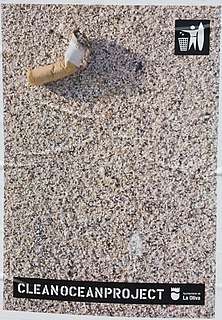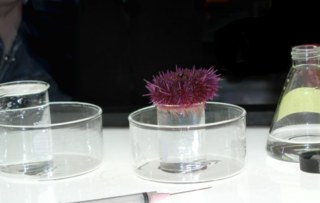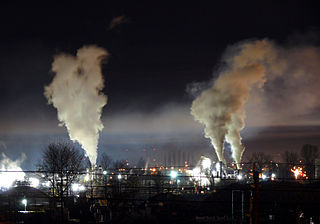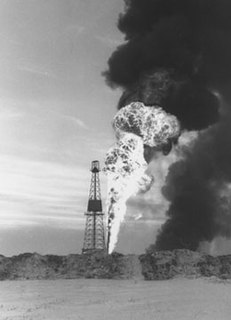Related Research Articles

Water quality refers to the chemical, physical, and biological characteristics of water based on the standards of its usage. It is most frequently used by reference to a set of standards against which compliance, generally achieved through treatment of the water, can be assessed. The most common standards used to monitor and assess water quality convey the health of ecosystems, safety of human contact, extend of water pollution and condition of drinking water. Water quality has a significant impact on water supply and oftentimes determines supply options.

Environmental protection is the practice of protecting the natural environment by individuals, organizations and governments. Its objectives are to conserve natural resources and the existing natural environment and, where possible, to repair damage and reverse trends.

Environmental remediation deals with the removal of pollution or contaminants from environmental media such as soil, groundwater, sediment, or surface water. Remedial action is generally subject to an array of regulatory requirements, and may also be based on assessments of human health and ecological risks where no legislative standards exist, or where standards are advisory.

Water reclamation is the process of converting municipal wastewater (sewage) or industrial wastewater into water that can be reused for a variety of purposes. Types of reuse include: urban reuse, agricultural reuse (irrigation), environmental reuse, industrial reuse, planned potable reuse, de facto wastewater reuse. For example, reuse may include irrigation of gardens and agricultural fields or replenishing surface water and groundwater. Reused water may also be directed toward fulfilling certain needs in residences, businesses, and industry, and could even be treated to reach drinking water standards. Treated municipal wastewater reuse for irrigation is a long-established practice, especially in arid countries. Reusing wastewater as part of sustainable water management allows water to remain as an alternative water source for human activities. This can reduce scarcity and alleviate pressures on groundwater and other natural water bodies.

Aquatic toxicology is the study of the effects of manufactured chemicals and other anthropogenic and natural materials and activities on aquatic organisms at various levels of organization, from subcellular through individual organisms to communities and ecosystems. Aquatic toxicology is a multidisciplinary field which integrates toxicology, aquatic ecology and aquatic chemistry.

Air pollution is a concern in British Columbia, Canada because of its effects on health and visibility. Air quality is influenced in British Columbia (BC) by numerous mountain ranges and valleys, which complicate atmospheric pollution dispersion and can lead to high concentrations of pollutants such as particulate matter from wood smoke.

The Safe Drinking Water Act (SDWA) is the principal federal law in the United States intended to ensure safe drinking water for the public. Pursuant to the act, the Environmental Protection Agency (EPA) is required to set standards for drinking water quality and oversee all states, localities, and water suppliers that implement the standards.

Soil contamination, soil pollution, or land pollution as a part of land degradation is caused by the presence of xenobiotic (human-made) chemicals or other alteration in the natural soil environment. It is typically caused by industrial activity, agricultural chemicals or improper disposal of waste. The most common chemicals involved are petroleum hydrocarbons, polynuclear aromatic hydrocarbons, solvents, pesticides, lead, and other heavy metals. Contamination is correlated with the degree of industrialization and intensity of chemical substance. The concern over soil contamination stems primarily from health risks, from direct contact with the contaminated soil, vapour from the contaminants, or from secondary contamination of water supplies within and underlying the soil. Mapping of contaminated soil sites and the resulting cleanups are time-consuming and expensive tasks, and require expertise in geology, hydrology, chemistry, computer modeling, and GIS in Environmental Contamination, as well as an appreciation of the history of industrial chemistry.
In the United States, public drinking water is governed by the laws and regulations enacted by the federal and state governments. Certain ordinances may also be created at a more local level. The Safe Drinking Water Act (SDWA) is the principal federal law. The SDWA authorizes the United States Environmental Protection Agency (EPA) to create and enforce regulations to achieve the SDWA goals.
Environmental policy in China is set by the National People's Congress and managed by the Ministry of Environmental Protection of the People's Republic of China. The Center for American Progress has described China's environmental policy as similar to that of the United States before 1970. That is, the central government issues fairly strict regulations, but the actual monitoring and enforcement are largely undertaken by local governments that have a greater interest in economic growth. The environmental work of non-governmental forces, such as lawyers, journalists, and non-governmental organizations, is limited by government regulations. Under the Ministry of Environmental Protection of the People's Republic of China, the Department of Policies, Laws, and Regulations is in charge of establishing and strengthening basic laws and policies such as environmental laws, administrative policies and economical regulations. It is also responsible for the development of national environmental protection policy and macro strategy.
To protect the environment from the adverse effects of pollution, many nations worldwide have enacted legislation to regulate various types of pollution as well as to mitigate the adverse effects of pollution.
Drinking water quality in the United States is generally safe. In 2016, over 90 percent of the nation's community water systems were in compliance with all published U.S. Environmental Protection Agency (EPA) standards. Over 286 million Americans get their tap water from a community water system. Eight percent of the community water systems—large municipal water systems—provide water to 82 percent of the US population.
Drinking water quality standards describes the quality parameters set for drinking water. Despite the truth that every human on this planet needs drinking water to survive and that water may contain many harmful constituents, there are no universally recognized and accepted international standards for drinking water. Even where standards do exist, and are applied, the permitted concentration of individual constituents may vary by as much as ten times from one set of standards to another.

Air pollution is the release of pollutants into the air that are detrimental to human health and the Earth. In Canada, air pollution is regulated by standards set by the Canadian Council of Ministers of the Environment (CCME), an inter-governmental body of federal, provincial and territorial Ministers responsible for the environment. Air pollution from the United States and to lesser extent Canada; caused by metal smelting, coal-burning for utilities, and vehicle emissions has resulted in acid rain, has severely impacted Canadian waterways, forest growth, and agricultural productivity.

Pollution is an environmental issue in Canada. It has posed health risks to the Canadian population and is an area of concern for Canadian lawmakers. Air, water and soil pollution as well as the health effects associated with these three types of pollution, are prominent points of contention in modern Canadian society.
Directive 98/83/EC concerns the quality of drinking water and forms part of the regulation of water supply and sanitation in the European Union.

The province of New Brunswick has created and implemented various Acts, such as the Clean Environment Act, Clean Air Act, and the Clean Water Act, throughout history to ensure that the environment is considered and protected throughout various project. These acts describe the process that will be undertaken to assess the impact of projects, and the steps to be taken when certain situations arise.
The maximum acceptable toxicant concentration (MATC) is a value that is calculated through aquatic toxicity tests to help set water quality regulations for the protection of aquatic life. Using the results of a partial life-cycle chronic toxicity test, the MATC is reported as the geometric mean between the No Observed Effect Concentration (NOEC) and the lowest observed effect concentration (LOEC).

Groundwater pollution occurs when pollutants are released to the ground and make their way into groundwater. This type of water pollution can also occur naturally due to the presence of a minor and unwanted constituent, contaminant, or impurity in the groundwater, in which case it is more likely referred to as contamination rather than pollution. Pollution can occur from on-site sanitation systems, landfills, effluent from wastewater treatment plants, leaking sewers, petrol filling stations or from over application of fertilizers in agriculture. Pollution can also occur from naturally occurring contaminants, such as arsenic or fluoride. Using polluted groundwater causes hazards to public health through poisoning or the spread of disease.

Jacqueline Horswell is an English-born New Zealand environmental microbiologist who specialises in research into the waste society produces, its effect on the environment, and how it can be managed. Her work focuses particularly on measuring the effect of microbial and chemical contaminants in sewage sludge and the safe reuse of biosolids as fertilizer by the planting of native trees to filter and inactivate pollutants from the sludge and the use of vermiculture. Horswell is involved in consultation with communities in New Zealand and has contributed to official guidelines for the management of biosolids. Her research has also provided information about soil microbial communities for forensic science using microbial cultures and DNA sequencing. Since 2018, Horswell has been a lecturer at Massey University.
References
- ↑ "About CCME". Canadian Council of Ministers of the Environment. Retrieved 4 January 2022.
- ↑ "About CCME". CCME. Archived from the original on 2013-02-18. Retrieved 11 March 2013.
- ↑ "Federal, provincial, and territorial relations". Environment and Climate Change Canada. Retrieved 4 January 2022.
- ↑ "Current Activities CCME". Canadian Council of Ministers of the Environment. Retrieved 4 January 2022.